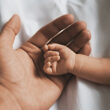As a high school cross country and track runner, I didn’t realize my missing period was something I should not ignore. Though the absence of a monthly bleed seemed relatively harmless—even convenient at the time—there were future implications for my hormonal, bone, and overall health that could have been addressed earlier had I had increased cycle knowledge. What I’ve learned over time has convicted me that female athletes need to learn fertility awareness to remain competitive in the long run.
No period, no big deal?
Like many American youth, I participated in a variety of sports while growing-up. I transitioned from activity in multiple sports to singularly-focused training as a distance runner in high school. When I hadn’t begun menstruating by age 16, my pediatrician attributed the cause to family history of late puberty and my high level of vigorous physical activity, but expressed no significant concern. Each year at my annual sports physical, I was sent on my way without deeper investigation into why I was not menstruating.
Fast forward to college. The love for running that budded in my youth propelled me to compete as a Division 1 collegiate cross country and track runner. Unsurprisingly, as my training load increased from high school to college, my period never came. During my freshman year, as I became immersed in the collegiate running world, I quickly learned that missing periods, or amenorrhea, were prevalent at this level of female distance running.
What was even more common than teammates without periods? Bone-related stress injuries among female runners. But I didn’t yet understand the connection.
When I learned the connection between missing periods and bone injuries in female athletes
Early in my collegiate sophomore cross country season, an MRI confirmed that prolonged pain in my foot was a metatarsal stress fracture. With this injury, our team’s sports medicine physician started to ask questions about my menstrual history, which led to a diagnosis of primary amenorrhea- when a female has not started a period by age 15. The doctor explained the connection between low bone density, absence of period, and low body mass, known as the female athlete triad.
He informed me that prolonged absence of menses (which indicated too low estrogen and progesterone levels) was likely weakening my bones and posing an increased likelihood of fracture. The prescribed first line of treatment was oral contraceptive pills (OCPs) as a means of “kick starting” my period. I was told by my doctor that taking the OCPs would help protect my bones from future stress fractures. However, as I later learned, this was not actually the case.
Why oral contraceptives aren’t the answer to amenorrhea in athletes
After months on the pill, through my own further research, I learned that the low-dose synthetic hormones in OCP’s and the monthly bleed caused by their withdrawal (during the week of placebo pills) are not effective in improving bone density in females with oligomenorrhea (irregular periods) [1]. Although OCPs may seem like an easy way to “fix” irregular periods (or no periods at all), the hormone withdrawal bleed women experience when taking them isn’t a true period because it doesn’t follow ovulation. Oral contraceptives don’t treat the underlying hormonal insufficiency leading to little or no ovulation (manifested as few or no periods), and they can actually have negative effects on women and girls’ bone health.
For example, a 2019 cross-sectional review of the effect of hormonal contraception on peak bone density accrual detected lower bone mineral density (BMD) in adolescent females taking oral contraceptive pills [1]. Peak bone mineral density (BMD) is reached at age 20, and bone development is modulated by estradiol (the most common form of estrogen in the body), so healthy estradiol levels during the preceding teenage years are crucial for bone development.
A 2019 cross-sectional review of the effect of hormonal contraception on peak bone density accrual detected lower bone mineral density (BMD) in adolescent females taking oral contraceptive pills.
Furthermore, a study of 210 Japanese female athletes indicated that at least 1 year of amenorrhea during a female athlete’s teenage years increased her risk for low BMD in her twenties by 23-fold [2]. And while I never used the Depo-Provera birth control shot, Depo-Provera has even more devastating bone mineral density impacts, especially for adolescent girls.
Recurrent injury forced me to retire from collegiate athletic competition
After my first stress fracture, I bounced back to a similar training load and found myself in a vicious cycle of injury and reinjury for the next year. Ultimately, I faced 2 more stress fractures in less than a year, requiring me to prematurely hang up my shoe laces and retire from collegiate sports, at my doctor’s recommendation. Looking back, I see now what I couldn’t have known then: my body needed time to heal, sufficient energy for menstruation, and bio-identical hormone support to regulate my hypothalamic-pituitary-adrenal (HPA) axis and promote regular cycles.
Many female athletes believe that period loss is normal
Though I am thankful for my collegiate running experience, in hindsight, I wish I had been informed during high school of the importance of the menstrual cycle and proper levels of estrogen and progesterone both for bone development and overall health. For me and many other high school and college athletes, singular focus on immediate performance results while dismissing cycle irregularities poses long-term health risks. One study indicates 44% of female high school athletes believe losing their cycle is a “normal” part of training [3]. Particular to the sport of running, menstrual abnormalities affect up to 51% of female endurance runners [4].
For me and many other high school and college athletes, singular focus on immediate performance results while dismissing cycle irregularities poses long-term health risks. One study indicates 44% of female high school athletes believe losing their cycle is a “normal” part of training. Particular to the sport of running, menstrual abnormalities affect up to 51% of female endurance runners.
The good news? In recent years, emerging research has demonstrated that female athletic training must be different from men’s. Groups like the FASTR Research Group based out of Stanford Medical School and the Female Athlete Program at Boston Children’s Hospital strive to close the gap on female-specific athletic research and translate research findings into practical recommendations for female athletes and coaches, with a particular emphasis on the importance of a girl’s period to her athletic performance.
Why I want every female athlete to learn fertility awareness during her high school years
Teaching fertility awareness methods (FAMs) to girls during their middle and high school years can be an important part of helping them build healthy bodies, create healthy relationships around their bodies and exercise, and understand the mutual impact of hormones and training on one another that will impact them throughout their lives. This is especially true for female athletes.
Teaching fertility awareness methods (FAMs) to girls during their middle and high school years can be an important part of helping them build healthy bodies, create healthy relationships around their bodies and exercise, and understand the mutual impact of hormones and training on one another that will impact them throughout their lives. This is especially true for female athletes.
I, like many high school girls, could have benefited from a presentation, a conversation with a coach, or a doctor’s intervention when menstruation had not begun by 15. Whether a girl has not started her period (primary amenorrhea) or her cycle has ceased (secondary amenorrhea) due to athletic training, it’s important to raise attention around changes to a girl’s cycle due to athletic activity.
Teenage girls should know more about their bodies than whether or not they’re having a period. Learning fertility awareness methods provides them with important health information that can inform their athletic training and medical care. FAMs empower women to track biomarkers such as cervical mucus to monitor whether the main event of the cycle—ovulation—is actually occurring. Doctors trained in restorative reproductive medicine can use information about a teen’s menstrual cycle to inform her individualized treatment plan. The American College of Obstetricians and Gynecologists (ACOG) recommends menstrual cycle history as a fifth vital sign in the care of girls and teens [1].
How long does it take for teen cycles to regulate?
After the onset of puberty, it takes up to three years for the HPA axis to fully mature in the majority of adolescent girls, after which they typically experience regular cycles [5]. During these years, cycles should be moving towards regular, ovulatory cycles with a healthy luteal phase (that is, the phase post-ovulation, preceding the start of the next period). Ovulation is key for health benefits to protect and build the bones, but just because a teen girl has monthly bleeding doesn’t automatically mean she’s ovulating.
Females who learn to chart from the time of puberty using FAMs take an active role in their health and have earlier detection of cycle irregularities. FAMs allow a woman to recognize menstrual changes that are the body’s way of communicating an underlying health need. Charting her cycle can help a teen girl active in sports connect how she is feeling in athletic training with where she’s at in her cycle, which can inform decisions about athletic training, nutrition, and rest, as the U.S. Women’s National Team found before their 2019 World Cup victory. Assessing cycle patterns and symptoms, such as painful periods, acne, or overall low energy, is also important for revealing underlying hormonal imbalances that may require further treatment.
Fertility awareness education for female athletes in high school
I propose that all high school female sports programs should teach fertility awareness (i.e. provide presentations to their athletes on periods, nutrition, and the unique needs of the female body when it comes to sports training and performance). Cycle education during the high school years can be an important part of promoting healthy female growth and development, fostering a balanced relationship around the body and exercise, and understanding the mutual impact of hormones and training on one another. This approach has long-term benefits, in that it can help girls prevent injury, keep them in competitive sports longer, and build sustainable, life-long exercise habits.
I see now, in my late twenties, that long-term overall health and fertility is more important than one’s athletic performance results during one’s teens and early twenties. I’ve learned that a more balanced, patient approach to running in high school and college can support proper bone development and ovulatory cycles.
There is great hope for the future of female-centric approaches to sport and exercise, beginning with youth and adolescent girls. When we combine this with cycle education and fertility awareness instruction, young female athletes will be empowered in sport and health!











